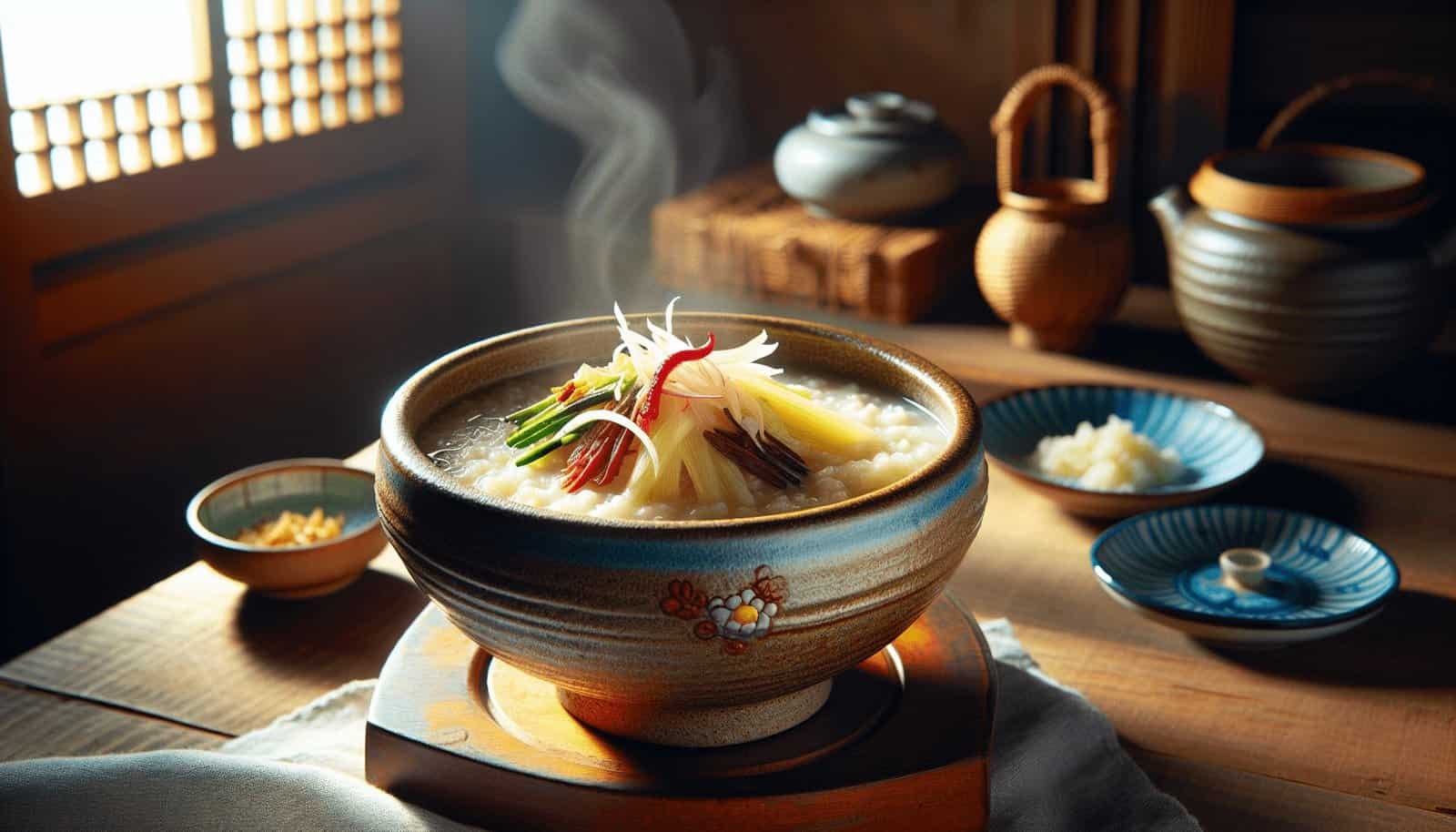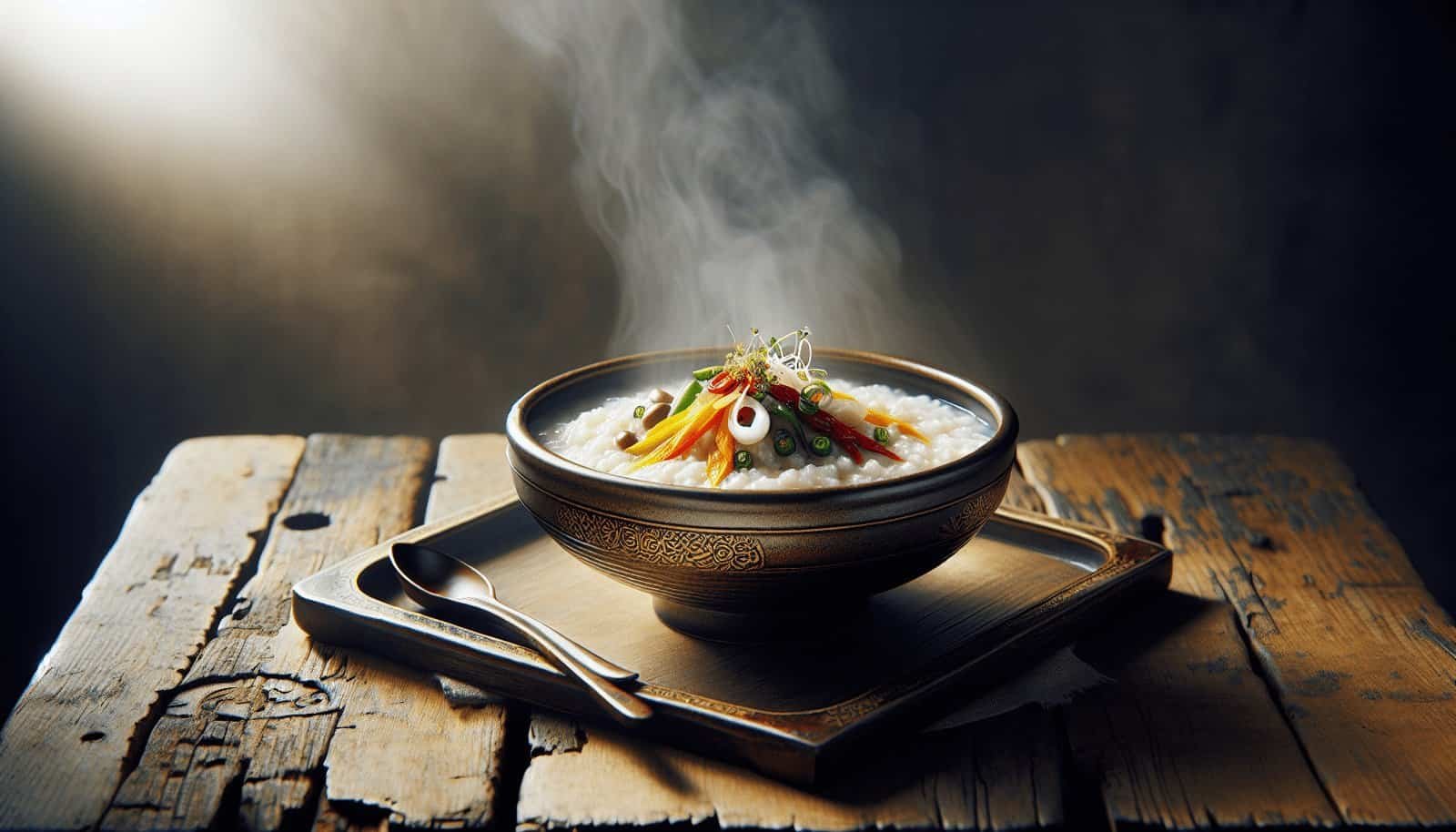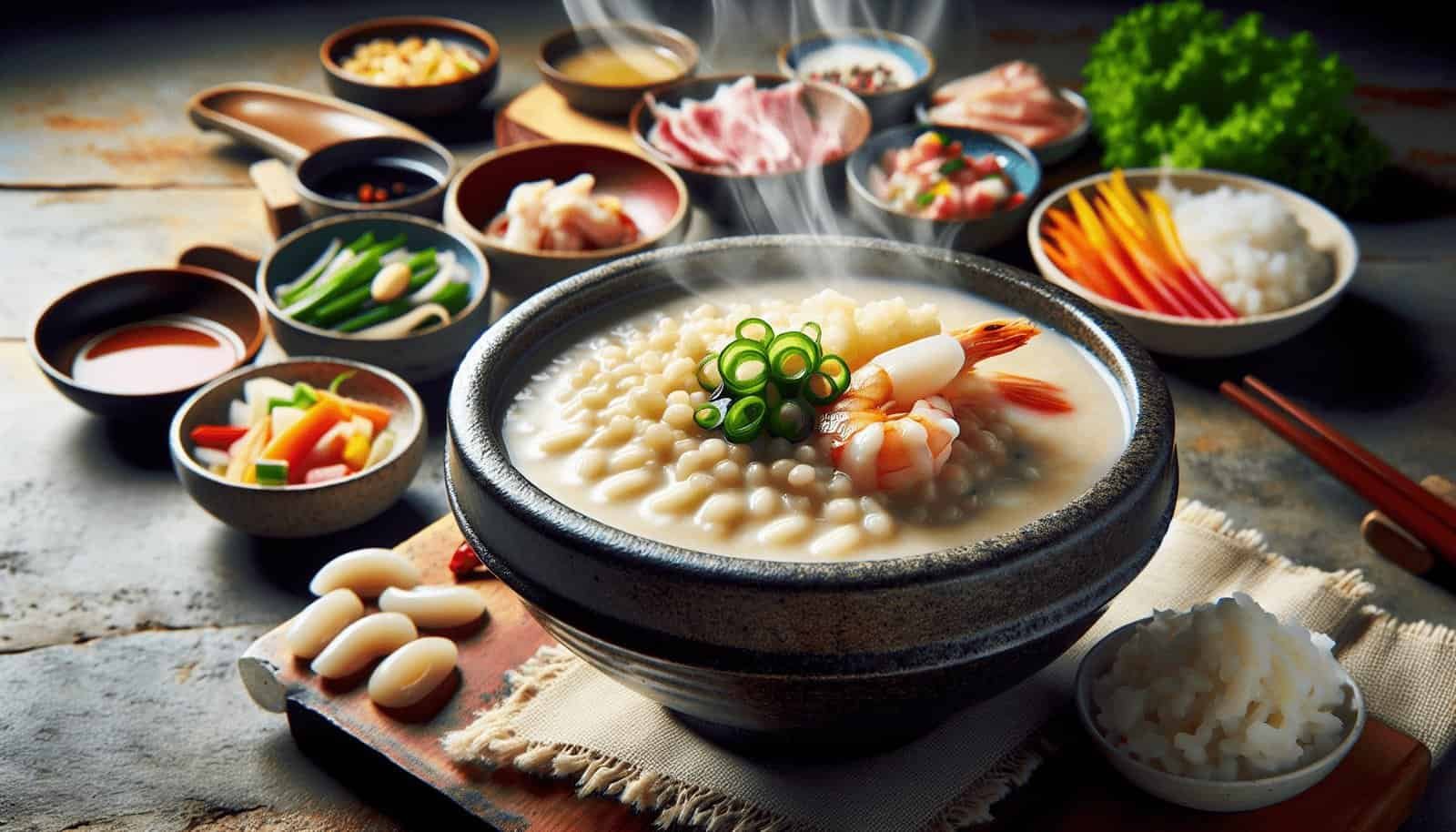If you’ve ever wanted to embark on a culinary adventure and broaden your taste buds, then traditional Korean porridges, or juk, are a must-try. Bursting with flavors and cooked to smooth perfection, juk is a delightful and comforting dish that has been enjoyed in Korean culture for centuries. In this article, we will explore the art of preparing and serving traditional Korean juk, unraveling its secrets and guiding you on a journey to create a truly authentic and delicious dining experience. Whether you’re a novice in the kitchen or a seasoned cook, get ready to discover the joy of juk.

Choosing the Right Ingredients
Selecting the base grain
When it comes to making juk, the first step is selecting the right base grain. Traditional juk recipes often use short-grain rice, which creates a creamy and smooth texture. However, you can also experiment with other grains such as millet or barley to add a different flavor and texture to your porridge. Make sure to choose high-quality grains for the best results.
Adding additional ingredients
While the base grain forms the foundation of juk, the additional ingredients play a crucial role in enhancing the flavor. You can add various ingredients such as vegetables, meats, seafood, and even beans to create a delicious and nutritious porridge. The choice of ingredients will depend on your personal preferences and dietary restrictions.
Preparing the Grains
Washing and soaking the grains
Before cooking the grains, it is important to wash them thoroughly to remove any impurities or excess starch. Rinse the grains under cold water until the water runs clear. After washing, you can soak the grains in water for at least 30 minutes or up to overnight. Soaking helps to soften the grains and reduces the cooking time.
Cooking the grains
Once the grains are washed and soaked, it’s time to cook them to perfection. You can cook the grains using various methods, including stovetop cooking, pressure cooker, slow cooker, or an instant pot. Each method has its own advantages and yields slightly different results, so choose the method that suits your needs and kitchen equipment. Follow the instructions carefully for the best outcome.

Cooking Methods for Juk
Stovetop Cooking
Stovetop cooking is the traditional way of making juk. It involves simmering the grains in a pot over low heat until they become soft and creamy. This method requires regular stirring to prevent the grains from sticking to the bottom of the pot and burning. Stovetop cooking allows for better control over the consistency and texture of the porridge.
Pressure Cooker
Using a pressure cooker can significantly reduce the cooking time for juk. The high-pressure environment helps to break down the grains faster, resulting in a smooth and creamy porridge. Simply add the grains and desired amount of water to the pressure cooker, seal the lid, and cook according to the manufacturer’s instructions. Be sure to release the pressure before opening the lid.
Slow Cooker
For a hands-off approach, you can use a slow cooker to make juk. This method is perfect for busy individuals who want to come home to a warm bowl of porridge. Place the grains and water in the slow cooker, set it to low heat, and let it cook for several hours. The slow cooker method allows the flavors to develop slowly and evenly.
Instant Pot
The Instant Pot is a versatile kitchen appliance that can also be used to cook juk. It combines the functions of a pressure cooker, slow cooker, and rice cooker, making it a convenient option for making porridge. Simply add the grains and water to the Instant Pot, select the appropriate cooking function, and let it do its magic. The Instant Pot offers a quick and efficient way to prepare juk.
Enhancing Flavor with Broth
Making a vegetable broth
A flavorful broth is essential for adding depth and richness to your juk. To make a vegetable broth, you can simmer a combination of vegetables such as onions, carrots, celery, and mushrooms in water. You can also enhance the flavor by adding herbs and spices like bay leaves, peppercorns, and thyme. Simmer the broth for a while to allow the flavors to meld together before straining it.
Preparing a meat-based broth
If you prefer a meaty flavor in your juk, you can make a delicious meat-based broth. Simply simmer bones or meat such as chicken, beef, or pork with vegetables and aromatics like onions, garlic, and ginger. The longer you simmer the broth, the more flavorful it will become. Remove the bones and meat from the broth before using it as a base for your porridge.
Using pre-made broths
If you’re short on time or prefer convenience, you can opt for pre-made broths available in stores. Look for high-quality broths without any artificial additives or excessive sodium. You can find vegetable, chicken, beef, and even seafood broths that can add a savory depth of flavor to your juk. Just be sure to taste and adjust the seasoning accordingly, as pre-made broths can vary in flavor intensity.

Adding Seasonings
Salt and Pepper
A simple way to enhance the flavor of your juk is by adding salt and pepper. These basic seasonings help to bring out the natural flavors of the ingredients and balance the overall taste of the porridge. Start with a small amount and adjust to your liking, keeping in mind that the broth and other seasonings may also contribute to the overall saltiness.
Soy Sauce
Soy sauce is a staple in Korean cuisine and can add a rich umami flavor to your juk. Use a high-quality soy sauce that is not overly salty. Add it gradually, tasting as you go, to ensure the right balance of flavors. Soy sauce can also contribute to the color of your juk, giving it a beautiful golden hue.
Fish Sauce
For seafood lovers, fish sauce is a fantastic seasoning option. It adds a unique savory and slightly tangy flavor to the juk. A little goes a long way, so use it sparingly and adjust according to your taste preferences. If you’re not a fan of fish sauce, you can omit it or substitute it with a vegetarian alternative like soy sauce or seaweed-based seasonings.
Sesame Oil
Sesame oil is a key ingredient in Korean cuisine and can add a nutty and aromatic flavor to your juk. Drizzle a small amount of sesame oil over the cooked juk just before serving to enhance the overall taste. Be cautious not to use too much, as sesame oil has a strong flavor that can overpower the other ingredients.
Garlic and Ginger
Garlic and ginger are common flavor enhancers in many Korean dishes, including juk. These aromatic ingredients add a subtle heat and freshness to the porridge. Finely mince or grate the garlic and ginger before adding them to the juk. Adjust the amount according to your taste preferences, remembering that their flavors can become more pronounced during cooking.
Scallions
Scallions, also known as green onions, provide a mild onion flavor and a pop of vibrant green color to your juk. Finely chop the white and green parts of the scallions and sprinkle them over the porridge just before serving. Scallions add a refreshing and aromatic element to the overall taste profile of the juk.
Incorporating Protein
Meat options
Meat can add a substantial amount of protein and flavor to your juk. Popular meat options include chicken, beef, pork, and even duck. You can use boneless or bone-in cuts, depending on your preference. Cook the meat separately before adding it to the juk, ensuring that it is fully cooked and tender. Shred or cube the cooked meat and stir it into the porridge during the final stages of cooking.
Seafood options
Seafood lovers can enjoy the delicate and briny flavors of juk by incorporating various types of seafood. Shrimp, crab, clams, and mussels are all excellent choices. Cook the seafood separately, adding them to the juk toward the end of the cooking process to prevent overcooking. The seafood will infuse the porridge with a delightful oceanic taste that pairs perfectly with the creamy base.
Vegetarian protein options
For those seeking vegetarian or plant-based protein sources, there are plenty of options to choose from. Tofu, tempeh, and seitan can provide a meaty texture and protein content to your juk. You can also add beans, such as lentils or chickpeas, for a nutritious and flavorful twist. Cook these protein options separately and add them to the juk as desired.

Garnishing Juk
Crunchy toppings
Adding crunchy toppings to your juk can provide a contrast in texture and create an exciting eating experience. Toasted rice, crispy fried shallots, or even crushed seaweed can add a delightful crunch to the creamy porridge. Sprinkle these toppings generously over the juk before serving to enhance its overall texture.
Fresh herbs
Fresh herbs can bring a burst of freshness and aroma to your juk. Herbs like cilantro, parsley, or mint can add a pop of color and flavor to the dish. Finely chop the herbs and garnish the juk just before serving to retain their freshness. The herbs will not only enhance the visual appeal but also contribute to the overall taste sensation.
Slices of vegetables
Thinly sliced vegetables can add a refreshing and vibrant element to your juk. Consider using cucumbers, radishes, or carrots as they provide a satisfying crunch and a splash of color. Arrange the vegetable slices on top of the juk as a garnish and let your creativity shine. The visual appeal of these colorful garnishes will make your juk even more appetizing.
Toasted sesame seeds
Toasted sesame seeds can add a delightful nutty flavor and a subtle crunch to your juk. Toast the sesame seeds in a dry pan over low heat until they turn golden brown and aromatic. Sprinkle the toasted sesame seeds generously over the juk just before serving. Their rich and toasty taste will elevate the overall flavor profile of the porridge.
Serving Juk
Hot vs. chilled juk
Typically, juk is served hot, especially during colder months. The warm and comforting nature of juk makes it a perfect dish to enjoy on chilly days. However, if you prefer a refreshing and lighter version, you can serve juk chilled or at room temperature. Chilled juk is particularly popular during the summer months, offering a cool and soothing meal option.
Individual serving bowls
Juk is traditionally served in individual bowls, allowing each person to customize their own toppings and seasonings. This not only adds a personal touch but also creates a sense of warmth and intimacy during mealtimes. Use small to medium-sized bowls with deep sides to accommodate the porridge and its accompaniments comfortably.
Accompaniments
When serving juk, consider providing various accompaniments that allow each individual to tailor their porridge to their liking. Common accompaniments include additional soy sauce, sesame oil, chopped scallions, and toasted sesame seeds. These condiments can be placed on the table, allowing each person to add them as desired. Additional side dishes like kimchi or pickles can also complement the flavors of the juk.

Traditional Juk Variations
Patjuk (Red Bean Porridge)
Patjuk is a classic Korean porridge made with sweet red beans, also known as adzuki beans. The beans are cooked until soft and then mashed to create a thick and creamy base. Patjuk is traditionally served during special occasions like winter solstice and is often garnished with glutinous rice balls and roasted nuts.
Hobakjuk (Pumpkin Porridge)
Hobakjuk is a delightful porridge made with pumpkin, creating a velvety and naturally sweet base. The pumpkin is simmered until tender and then blended into a smooth puree. Hobakjuk is often enjoyed as a dessert or a light snack and can be garnished with roasted pumpkin seeds or a sprinkle of cinnamon.
Pyeonyuk (Chicken Porridge)
Pyeonyuk is a hearty and satisfying chicken porridge that is perfect for comforting meals. It is made by simmering chicken with aromatic vegetables to create a rich and savory broth. The cooked chicken is shredded and added to the porridge, providing a substantial protein source. Pyeonyuk can be garnished with chopped scallions, crispy fried shallots, and a drizzle of sesame oil.
Tips for Perfect Juk
Consistency of porridge
The consistency of juk is a matter of personal preference. Some people prefer a thick and creamy porridge, while others enjoy a thinner and more soup-like consistency. Adjust the amount of liquid accordingly to achieve the desired texture. Add more broth or water for a thinner juk, or cook the porridge longer to thicken it up.
Storing and reheating
Juk can be made in larger batches and stored for future meals. Allow the porridge to cool completely before transferring it to an airtight container. Refrigerate the juk for up to three days, or freeze it for longer storage. When reheating, add a splash of water or broth to the porridge to restore its desired consistency.
Experimenting with flavors
Don’t be afraid to get creative and experiment with flavors when making juk. Feel free to add your favorite ingredients, spices, or seasonings to create unique and personalized variations. With its versatile nature, juk can be customized to suit different taste preferences and dietary needs. Have fun exploring new combinations and discover your own signature juk recipe.
Now that you have a comprehensive understanding of how to prepare and serve traditional Korean porridges (juk), it’s time to unleash your culinary creativity. Whether you stick to the classic recipes or put your own spin on them, juk is sure to provide a comforting and nourishing meal that will warm both your body and soul. So grab your apron, gather your ingredients, and embark on a delicious juk-making adventure!
